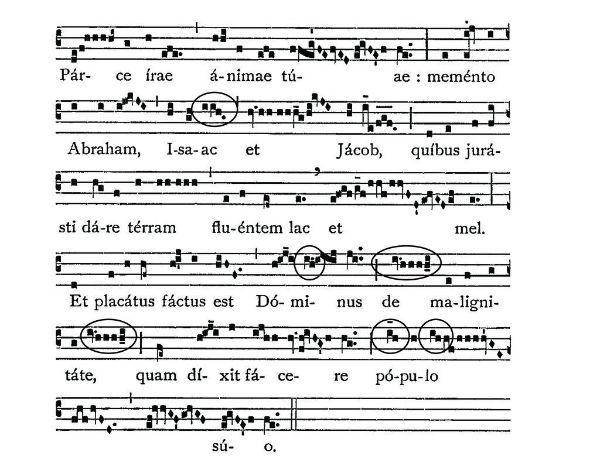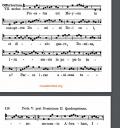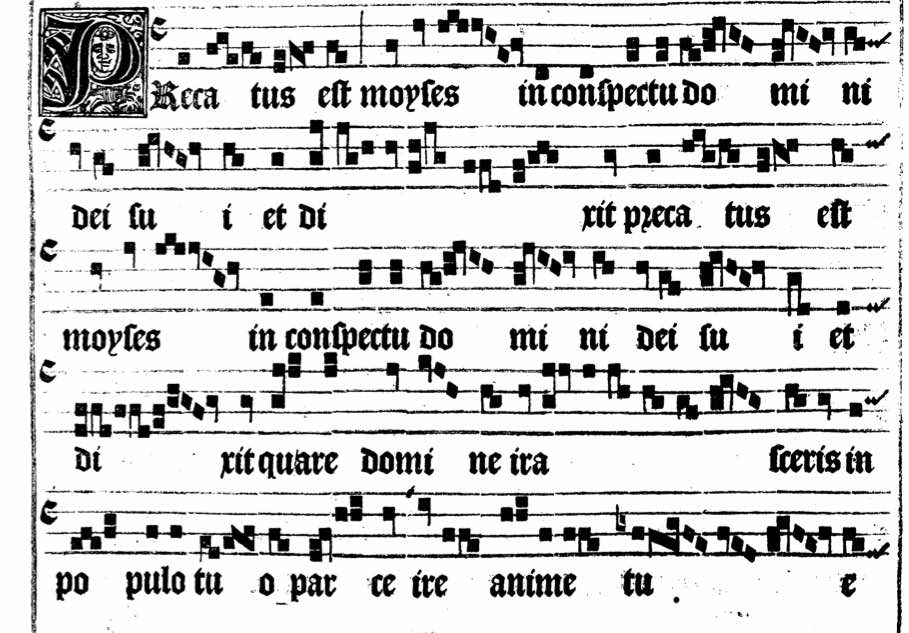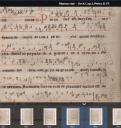Offertory - Precatus est Moyses
-
Does anyone have any insights about this coming Sunday's offertory "Precatus est Moyses"? Specifically, I wonder why the long introductory phrase "Precatus est Moyses in conspectu Domini Dei sui et dixit" is repeated almost (but not exactly) note-for-note? How should this be interpreted? I was thinking about making the repeated text a little more plaintive and expressive. What's your take?
...And isn't this consturction highly unusual for the idiom? -
Holy deponent verbs, Batman! I don't know what to tell you about interpretation, but the same thing happens in Jubilate Deo at "(universa) ter-(ra): only one note is changed.
-
Good catch, boy Robin. Yes, I suppose it's not unheard of to have some repeated material in the chants, particularly in the offertories. One of my personal favorites is the word "Dominus" from the Ave Maria offertory used durng Advent -- that one IS note for note. But the Precatus is certainly a strange animal, I think. It's almost as if it is intended to be two alternate versions of the same material, like an "ossia" or something.
Anyway, anyone else have thoughts on interpretation? When I looked it up in the Triplex, I noticed that the paleography, both in the Messine and St. Gall notations, seems to get a little more intense the second time around. -
I think this may have come up on the New Liturgical Movement, or on Aristotle Esguerra's blog. If you recall from Exodus 4:10, Moses had a speech impediment. The repeating of the first phrase is like a musical stutter, representing Moses' speech.
-
Laudetur Jesus Christus!
The Graduale Romanum (1961) repeats the first phrase, with almost identical notation. This doubling of the text is not found in the Missale Romanum (1962), nor in the Graduale Ordinis Praed. (1950).
Both the Offertoriale Triplex (1985) and Graduale Triplex (1979) contain the doubled text. -
I looked in Willi Apel's book Gregorian Chant (beginning p. 363 in my edition), where he includes this chant in his discussion of Offertory chants as a group. Since this is something that comes up every year when we hit this chant, I am copying the passage here.
Perhaps the most striking peculiarity of the Offertories is the fact that in not a few of them single words, groups of words, or entire phrases of the text are repeated, once or several times. Outside the Offertories there exists only one example of this procedure. ...
He counts eleven examples of what he calls the "normal procedure, that is, the immediate repeat of the initial portion of the text. ... In six of these [including Precatus est Moyses] the repeated portion of the text is sung to the same melody, resulting in the musical form a a b which was destined to play such a prominent role in the later development of music... ."
Another chant in which this repetition occurs is Vir erat, (from the book of Job) but neither our book nor the Liber gives the entire text he refers to. In his discussion of this Offertory, Apel says,
Whatever the ultimate cause of the textual repeats in the Offertories and their verses may have been --possibly nothing more than the necessity of prolonging the chant in conformity with the duration of the service-- .... the aim was usually pursued in a well-ordered and aesthetically comprehensible manner, by repeating the initial portion of the text (and often also its music) either immediately or at the end. -
Apel sometimes strains not to notice the obvious.
-
We will have Tenors & Basses sing first section, then Sopranos & sing the second. I think of these repeated sections as
the foundations of motivic development in the history of Western music. This was,in my musings, the seed that would
develop into the rondo & sonata forms of the Classical period. I love to think of the "continuity" of this thread throughout
music history. -
The repetition with development is an artistic device that goes back Psalms (at least)Lift up your gates, O ye princes, and be ye lifted up, O eternal gates: and the King of Glory shall enter in.
Who is this King of Glory? the Lord who is strong and mighty: the Lord mighty in battle.
Lift up your gates, O ye princes, and be ye lifted up, O eternal gates: and the King of Glory shall enter in.
Who is this King of Glory? the Lord of hosts, he is the King of Glory.Thanked by 1Ralph Bednarz -
The Lassus polyphonic setting of this is no stroll in the park either. Part of the audition package for the Rome trip. Wendy and I dueted S/T for the recording....that's a way to test part independence for your choirs!
-
Charles, I agree. We're doing the Lassus setting right after the chant. Since we have our first full rehearsal tomorrow
night I didn't have the courage (naivite?) to try the Palestrina setting. Also, since we do the OF, we will sing the Robert
Creighton setting of "I Will Arise and Go to My Father" after the Communio. We must get together one of these days. -
I was searching for more info on the (EF) Offertorio this coming Sunday, Precatus est Moyses, and came across this fascinating thread.
What struck me was the urgency of the prayer and the many dramatic intervals. If ever a prayer fit the current national and global climate, this is it, what with turmoil breaking out anew in the Middle East and the air of increasing uncertainty, desperation and mistrust that surrounds us. Maybe it's just this time of year--or maybe it's my Irish getting the better of me---but it's very hard not to be pessimistic and fearful about the future of our country and the world.
Dom Johner, as always, explains best the emotions generated by this antiphon:Here everything—the content, the construction, the expression—is on a grand scale. One can almost see the palpitations of the singer's breast, as it rises and sinks under the excessive emotions that rush in upon his soul. Everything is at stake: the salvation of an entire people. God has threatened it with destruction because it adored the golden calf. He had promised Moses, however, that He would make him the father of a new and better people. Hence Moses threw everything into the balance to save his people, the very nation which had so frequently embittered his life. That was spirit of the spirit of God! Here was shown a mercy akin to that of the Good Samaritan of the Gospel.
Violent agitation is expressed by the cumulation of fourths, bistrophas, tristrophas, pressus, and tritones. Ever more vehement becomes the beating of the singer's heart. As if to storm the gates of heaven itself, he now cries: Memento, Lord, Thou hast pledged Thy word. Thou canst not destroy us. -
http://www.youtube.com/watch?v=0Eipfjt8vrU
Found this on YouTube. This is the Schola Bellarmina, from what I can tell.Thanked by 1expeditus1 -
Though this text is also part of the OF's propers too, its conspicuous absence, or the absence of any similar text from our main stream liturgies is as alarming as the text itself.
Concerning the repetition: it's a standard rhetorical device:
repeating for emphasis,
repetition from different perspectives,
repeating a theme. probing deeper each time.
Some call it a "circular form "(not to be confused with circular reasoning)-
like holding a diamond and rotating it to see the different colors yet admiring the similarities in all the facets.
There are lots of fun theories on repetition of " Sanctus, Sanctus, Sanctus," but I have found in my studies of language that this is simply the the most ubiquitous form of the superlative,holy, holier,holiest.
Now we avoid repetition and are used to long linear sentences, with many subordinate thoughts; our thinking is more industrial, like an assembly line broken down into many small tasks. Repetition is regarded as a weakness. Repetition is regarded as a weakness. -
I have found in my studies of language that this is simply the the most ubiquitous form of the superlative, holy, holier, holiest.
Great observations. Yes, I believe there are many languages where comparative forms (holier, holiest) do not exist, and are formed by repeating the adjective. A kind of remnant of this still exists in modern English. Compare: "I am happy," "I am very happy," "I am very, very happy." -
Compare: "I am happy," "I am very happy," "I am very, very happy."
http://www.youtube.com/watch?v=lwESraWEpSU
-
Or in Latin, felix, felicior, felicissimus.
-
-
Thanks for the link! What a great resource with all the different recordings.
-
One of my favorite Offertorios this Sunday: Precatus est Moyses, a dramatic narrative like Vir erat in terra Hus nomine Job. The conclusion is so consoling:
And the Lord was appeased from the evil
which He had threatened to do to His people.
Has anyone else noticed the little motif that is repeated in the second half of the piece several times, a Re-Do that just tugs at your heartstrings, especially at de malignitate?

Tremendous rendition by Giovanni of Milan here.
Thanked by 1M. Jackson Osborn -
OK, I know I've done at least the text of this offertory before, but has anyone delved more deeply into the subject?
Thanks to such websites as http://www.ccwatershed.org/library/ , we can see that in the 19th century, the opening text was not repeated (see a couple of attached snippets).
So, what's the deal, exactly, and who made the decision to double that text phrase?
Obviously, the text isn't repeated in the bible verse, either, but things are often slightly rewritten for the propers, anyway.
 Screenshot_20170803-224228.png1080 x 1620 - 834K
Screenshot_20170803-224228.png1080 x 1620 - 834K
 Untitled2.jpg516 x 549 - 95K
Untitled2.jpg516 x 549 - 95K -
I will raise your 19th c. Graduale with the Graduale Sarisburiensis 1508,

N.B. Other ancient Graduale are available. ( I am away from my library and computer so cannot easily check other Graduale)but things are often slightly rewritten for the propers, anyway.
The Vulgate was one of three? translations produced by S. Jerome, I think the Missale text is usually the Vulgate text, but the Propers in the Graduale usually use one of the other texts.
There are various scholarly works on the differences between the MR and the GR, and the conclusion was that each text is ancient (but different) and it was not possible to ascertain which was the oldest (or correct) text.
. Add this to a list of questions that will not find an answer...who made the decision to double that text phrase?
 precatus.jpg909 x 633 - 99K
precatus.jpg909 x 633 - 99K -
The 1908 Gradual used the same texts as the ancient Graduals. Prior to this it was required to sing the identical texts found in the Missal of Trent. This is Likely the cause of the discrepancy.
St. Gall library is online somewhere if you want to go look in some 9th century Graduals.Thanked by 1tomjaw -
"Slightly rewritten" at least in the sense of trying to make the Proper seem like a complete thought/sentence, anyway. I almost always prefer the referenced text in the DR to whatever edited version is found in the Propers.
So, people clearly added and removed the text-doubling.
But why did they keep going back and forth? Does a version/translation of the bible have this text doubled in this way? -
The Propers are a form of prayer, and are ancient. They were not intended as a bible study class, I know many people think that the Mass should be a place to hear and study the scriptures but this is a largely a modern idea.
I believe that some people thought that the Missal text was original and wanted the GR texts to be changed. Their view held sway for a short while until it was shown the GR texts are just as important.
No bible should have the text doubling, but musical editions will use methods to amplify the text... -
I suppose it was ultimately the decision of Dom Joseph Pothier, who was in charge of the Vatican Gradual, which had a wide mandate for restoring/reforming texts and melodies. I'm no expert on the manuscripts, but after a quick look, it seems like all/most of the manuscripts have the repeated introduction.
The first phrase wasn't repeated in the Roman Missal after the revisions post-Trent, and despite the new Gradual, still wasn't in the 1962 revision.
Perhaps after Trent and even through the 19th century there was a disinclination (or maybe proscription) to diverge from the text of the Missal in new chant books. Even Dom Pothier's own 19th century Liber Gradualis matched the Missal text for Precatus. -
Ok, so, here's this one from a 12th C. manuscript that doesn't repeat it...
But, in the same set of results there's another 12th C. manuscript that does. So, anyway...
More importantly... why do some graduals show "in conspectu" on re, while others (including both my first snippet and @tomjaw 's clip) show it on mi ?
Each time I sing through this, I want it to be mi, and I wish it were, because it makes much more sense.
 Untitled.jpg683 x 723 - 173K
Untitled.jpg683 x 723 - 173K -
The Sarum book also has a clef change, the first line has the clef one line lower than the rest of the piece... I wonder what Laon or StGall have?
It is common for the Sarum Books to have slight differences in the chant...
N.B. We drove past Laon on the way to Switzerland a couple of days ago, and at the moment we are just over an hours drive from St Gall.
Welcome to the MusicaSacra Forum!
To participate in the discussions on Catholic church music, sign in or register as a forum member, The forum is a project of the Church Music Association of America.
Categories
- All Discussions21,110
- General Music Discussion8,218
- Job Openings197
- Management of Music Programs850
- Choral Matters533
- Church Documents and Rubrics524
- CMAA Notes302
- Events716
- For Newcomers: Read First26
- Sacred Polyphony546
- Hymnody872
- Gregorian Chant: General2,698
- ↳ Graduale Romanum and Liber Usualis368
- ↳ Graduale Simplex60
- ↳ Semiology63
- Vernacular Plainsong696
- Anglican Use and Anglican Chant68
- Organ, Other Instruments and Repertoire435
- New Composition/Works in Progress1,291
- Recordings232
- Music for Hispanic Ministry159
- Music Education: Children211
- Music Education: General222
- News Items245
- Positions Wanted2
- General Discussion: Catholicism739
- Amusements177
- General Discussion1,034
- Opinions117








